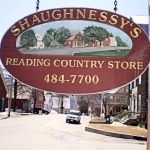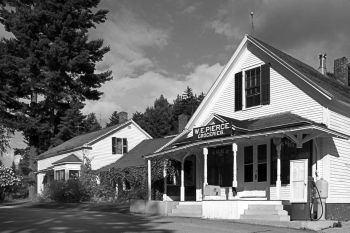 "There’s nothing like the little country store where you know everybody.
"There’s nothing like the little country store where you know everybody.
You’ve known ‘em since they were born. When they die you probably go
their funeral."
(HOST) VPR partnered last
summer with the Billings Farm and Museum in a project designed to encourage the exploration of Vermont’s working landscape and rural culture through our
historic General Stores. Today, we revisit commentator Tom Slayton’s consideration of how they’re a key part of Vermont’s social history.
(SLAYTON)
For more than a century, the general store was the nerve center and
supply line for many Vermont communities. They brought in basic
commodities like flour, sugar, and molasses, hardware, and feed grains,
as well as formerly exotic items like tea and coffee, spices, citrus
fruit, felt hats for the men and calicos for the women.
To
understand the vital role of the village store, it’s helpful to think a
bit about Vermont villages themselves a hundred years ago. In today’s
world of interstate highways, airports, television, and the Internet,
it’s hard for us to realize how isolated small hill towns in the Green
Mountains were – and how independent they had to be.
In
the 1800s, the mountains that dominate Vermont’s geography were
powerful barriers to trade, transport, and communication. Add to the
inconvenient mountains, impossible roads. For most of the year, the dirt
roads that connected all rural villages in the state were rough and
unpleasant. For six weeks in early spring they became impassable
mudholes.
And so,
Vermonters had to be self-sufficient in many ways. They became famous
for their ingenuity and frugality, and Vermonters, like rural people
everywhere, learned how to tell their own stories and make their own
music to entertain themselves.
Nevertheless,
by the 1850s, railroads could bring goods to most parts of the state,
and general stores became the place to get what you needed but couldn’t
make or grow yourself.

By the 1870s and 1880s, they had become not only
the commercial center but in many cases, the social hub of the town as
well.
People would go to
the store, not only to "do their trading," but also, in many instances,
to pick up their mail or wait for the appearance of the daily train and
meet some friends. Many general stores doubled as the local Post Office.
Some still do.
And
although most Vermont Post Offices have now found their own locations,
and the daily train is no longer an important community occurrence, many
general stores are still more than just a place to buy things. Teago
General Store in South Pomfret offers Justice of the Peace and Notary
Public services, and you can still buy a fishing license (and a fish
pole!) at F.H. Gillingham’s in Woodstock.
In those earlier days,
the storekeeper was an important person in town, known to just about
everyone. He or she was often consulted on local business matters, and many a
political career began in discussions around the store’s wood stove. Justin Smith Morrill, who was storekeeper in the Village of
Strafford in the 1850s, used the insights he gained there to become U.S.
representative in 1854 and later an important and influential U.S.
Senator. His home in Strafford is now a Vermont Historic Site, open for
visitors through the summer months. It’s a fascinating place to spend
an afternoon, a time-machine to take you back to the 19th century, when
the general store was the center of life in Vermont.